Marketing Management - Assignment
VerifiedAdded on 2021/08/04
|11
|2898
|88
AI Summary
Contribute Materials
Your contribution can guide someone’s learning journey. Share your
documents today.

Qualification GDM
Module Name Marketing Management
Module Number 404
Assignment Title Consumer Behaviour: Concept, Process and
Influencing Factors
Name of Candidate Thilakaraj Pamilashini
Candidate No. 449111813
Submission Date 28.09.2020
Word Count 1878
Module Name Marketing Management
Module Number 404
Assignment Title Consumer Behaviour: Concept, Process and
Influencing Factors
Name of Candidate Thilakaraj Pamilashini
Candidate No. 449111813
Submission Date 28.09.2020
Word Count 1878
Secure Best Marks with AI Grader
Need help grading? Try our AI Grader for instant feedback on your assignments.
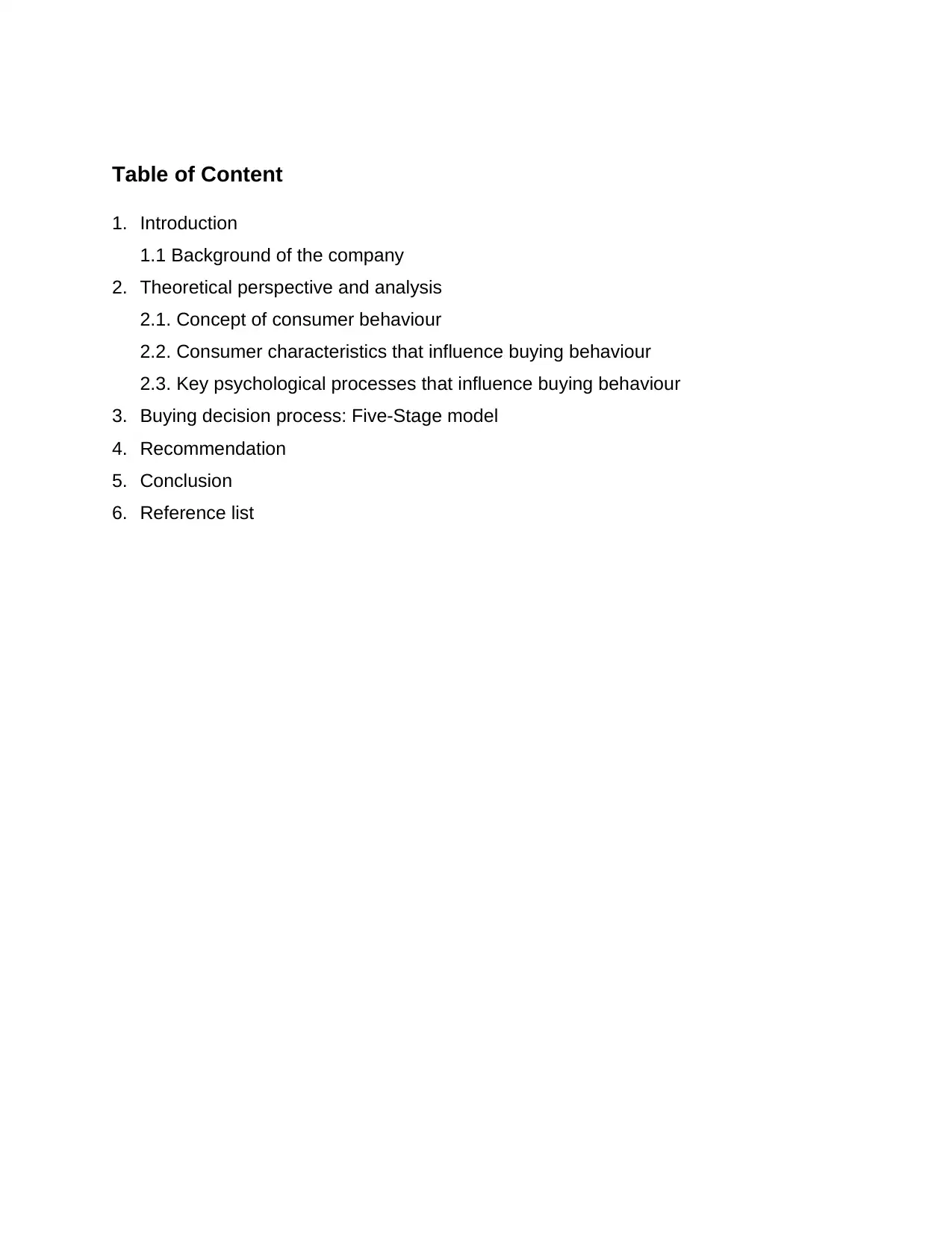
Table of Content
1. Introduction
1.1 Background of the company
2. Theoretical perspective and analysis
2.1. Concept of consumer behaviour
2.2. Consumer characteristics that influence buying behaviour
2.3. Key psychological processes that influence buying behaviour
3. Buying decision process: Five-Stage model
4. Recommendation
5. Conclusion
6. Reference list
1. Introduction
1.1 Background of the company
2. Theoretical perspective and analysis
2.1. Concept of consumer behaviour
2.2. Consumer characteristics that influence buying behaviour
2.3. Key psychological processes that influence buying behaviour
3. Buying decision process: Five-Stage model
4. Recommendation
5. Conclusion
6. Reference list
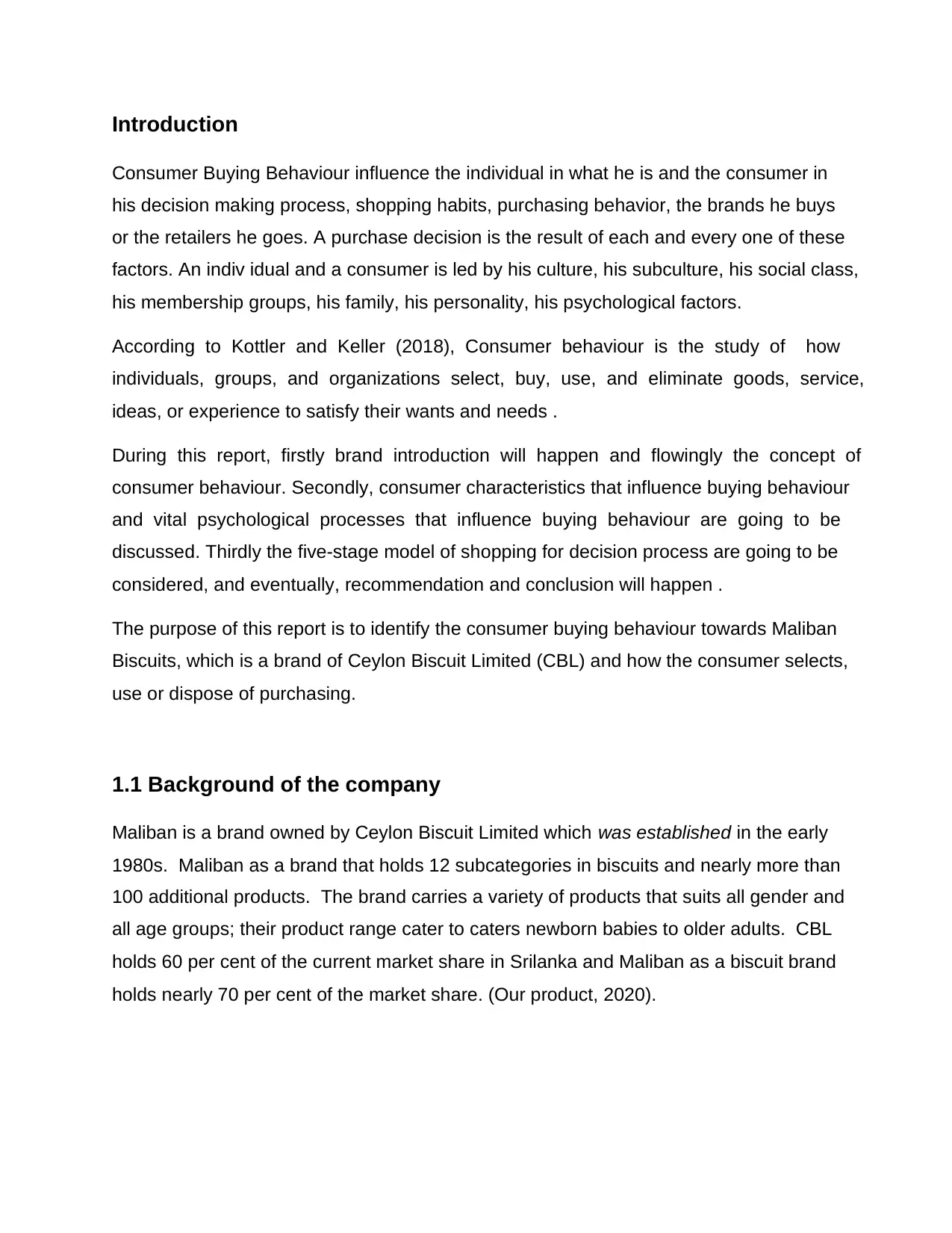
Introduction
Consumer Buying Behaviour influence the individual in what he is and the consumer in
his decision making process, shopping habits, purchasing behavior, the brands he buys
or the retailers he goes. A purchase decision is the result of each and every one of these
factors. An indiv idual and a consumer is led by his culture, his subculture, his social class,
his membership groups, his family, his personality, his psychological factors.
According to Kottler and Keller (2018), Consumer behaviour is the study of how
individuals, groups, and organizations select, buy, use, and eliminate goods, service,
ideas, or experience to satisfy their wants and needs .
During this report, firstly brand introduction will happen and flowingly the concept of
consumer behaviour. Secondly, consumer characteristics that influence buying behaviour
and vital psychological processes that influence buying behaviour are going to be
discussed. Thirdly the five-stage model of shopping for decision process are going to be
considered, and eventually, recommendation and conclusion will happen .
The purpose of this report is to identify the consumer buying behaviour towards Maliban
Biscuits, which is a brand of Ceylon Biscuit Limited (CBL) and how the consumer selects,
use or dispose of purchasing.
1.1 Background of the company
Maliban is a brand owned by Ceylon Biscuit Limited which was established in the early
1980s. Maliban as a brand that holds 12 subcategories in biscuits and nearly more than
100 additional products. The brand carries a variety of products that suits all gender and
all age groups; their product range cater to caters newborn babies to older adults. CBL
holds 60 per cent of the current market share in Srilanka and Maliban as a biscuit brand
holds nearly 70 per cent of the market share. (Our product, 2020).
Consumer Buying Behaviour influence the individual in what he is and the consumer in
his decision making process, shopping habits, purchasing behavior, the brands he buys
or the retailers he goes. A purchase decision is the result of each and every one of these
factors. An indiv idual and a consumer is led by his culture, his subculture, his social class,
his membership groups, his family, his personality, his psychological factors.
According to Kottler and Keller (2018), Consumer behaviour is the study of how
individuals, groups, and organizations select, buy, use, and eliminate goods, service,
ideas, or experience to satisfy their wants and needs .
During this report, firstly brand introduction will happen and flowingly the concept of
consumer behaviour. Secondly, consumer characteristics that influence buying behaviour
and vital psychological processes that influence buying behaviour are going to be
discussed. Thirdly the five-stage model of shopping for decision process are going to be
considered, and eventually, recommendation and conclusion will happen .
The purpose of this report is to identify the consumer buying behaviour towards Maliban
Biscuits, which is a brand of Ceylon Biscuit Limited (CBL) and how the consumer selects,
use or dispose of purchasing.
1.1 Background of the company
Maliban is a brand owned by Ceylon Biscuit Limited which was established in the early
1980s. Maliban as a brand that holds 12 subcategories in biscuits and nearly more than
100 additional products. The brand carries a variety of products that suits all gender and
all age groups; their product range cater to caters newborn babies to older adults. CBL
holds 60 per cent of the current market share in Srilanka and Maliban as a biscuit brand
holds nearly 70 per cent of the market share. (Our product, 2020).
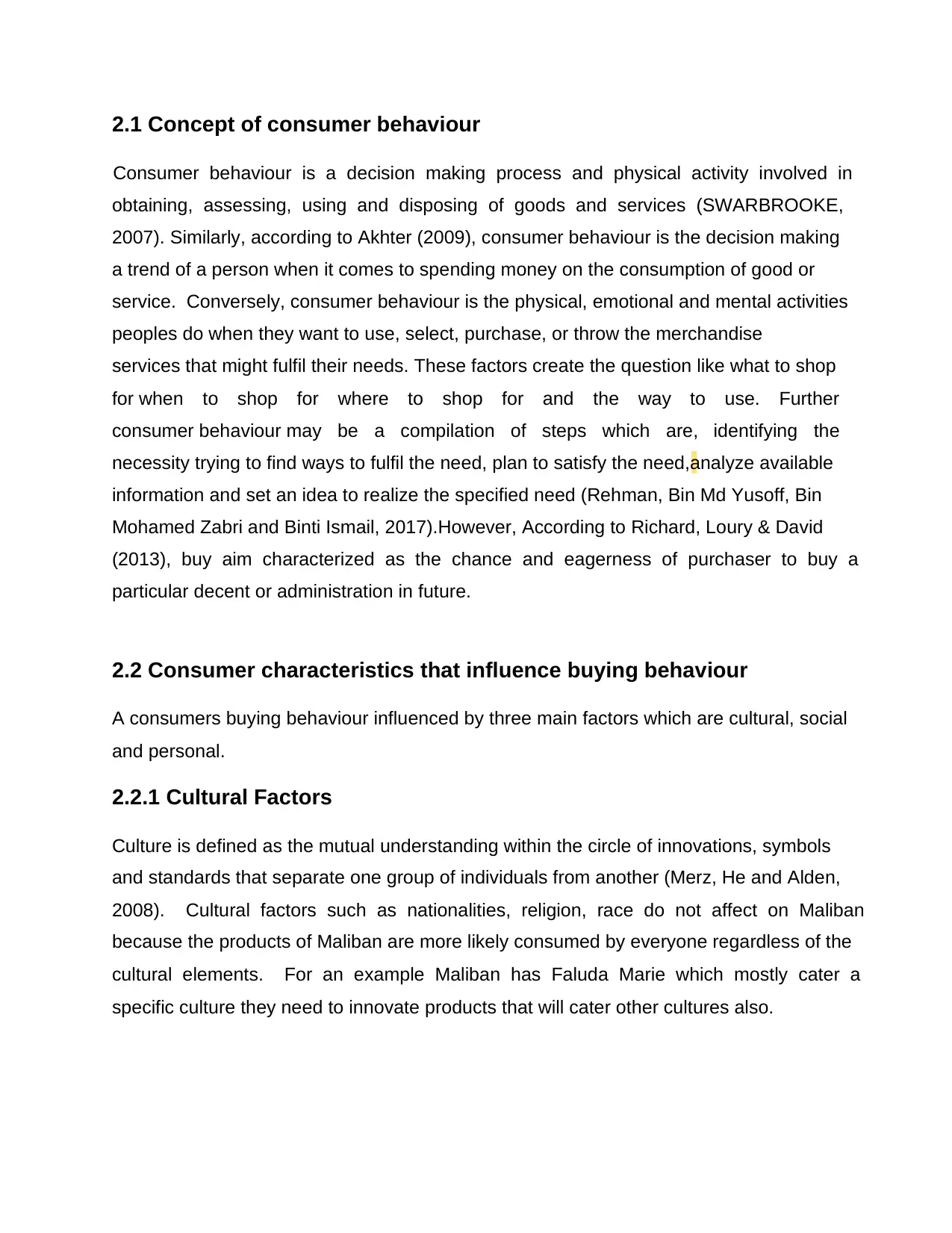
2.1 Concept of consumer behaviour
Consumer behaviour is a decision making process and physical activity involved in
obtaining, assessing, using and disposing of goods and services (SWARBROOKE,
2007). Similarly, according to Akhter (2009), consumer behaviour is the decision making
a trend of a person when it comes to spending money on the consumption of good or
service. Conversely, consumer behaviour is the physical, emotional and mental activities
peoples do when they want to use, select, purchase, or throw the merchandise
services that might fulfil their needs. These factors create the question like what to shop
for when to shop for where to shop for and the way to use. Further
consumer behaviour may be a compilation of steps which are, identifying the
necessity trying to find ways to fulfil the need, plan to satisfy the need,analyze available
information and set an idea to realize the specified need (Rehman, Bin Md Yusoff, Bin
Mohamed Zabri and Binti Ismail, 2017).However, According to Richard, Loury & David
(2013), buy aim characterized as the chance and eagerness of purchaser to buy a
particular decent or administration in future.
2.2 Consumer characteristics that influence buying behaviour
A consumers buying behaviour influenced by three main factors which are cultural, social
and personal.
2.2.1 Cultural Factors
Culture is defined as the mutual understanding within the circle of innovations, symbols
and standards that separate one group of individuals from another (Merz, He and Alden,
2008). Cultural factors such as nationalities, religion, race do not affect on Maliban
because the products of Maliban are more likely consumed by everyone regardless of the
cultural elements. For an example Maliban has Faluda Marie which mostly cater a
specific culture they need to innovate products that will cater other cultures also.
Consumer behaviour is a decision making process and physical activity involved in
obtaining, assessing, using and disposing of goods and services (SWARBROOKE,
2007). Similarly, according to Akhter (2009), consumer behaviour is the decision making
a trend of a person when it comes to spending money on the consumption of good or
service. Conversely, consumer behaviour is the physical, emotional and mental activities
peoples do when they want to use, select, purchase, or throw the merchandise
services that might fulfil their needs. These factors create the question like what to shop
for when to shop for where to shop for and the way to use. Further
consumer behaviour may be a compilation of steps which are, identifying the
necessity trying to find ways to fulfil the need, plan to satisfy the need,analyze available
information and set an idea to realize the specified need (Rehman, Bin Md Yusoff, Bin
Mohamed Zabri and Binti Ismail, 2017).However, According to Richard, Loury & David
(2013), buy aim characterized as the chance and eagerness of purchaser to buy a
particular decent or administration in future.
2.2 Consumer characteristics that influence buying behaviour
A consumers buying behaviour influenced by three main factors which are cultural, social
and personal.
2.2.1 Cultural Factors
Culture is defined as the mutual understanding within the circle of innovations, symbols
and standards that separate one group of individuals from another (Merz, He and Alden,
2008). Cultural factors such as nationalities, religion, race do not affect on Maliban
because the products of Maliban are more likely consumed by everyone regardless of the
cultural elements. For an example Maliban has Faluda Marie which mostly cater a
specific culture they need to innovate products that will cater other cultures also.
Secure Best Marks with AI Grader
Need help grading? Try our AI Grader for instant feedback on your assignments.
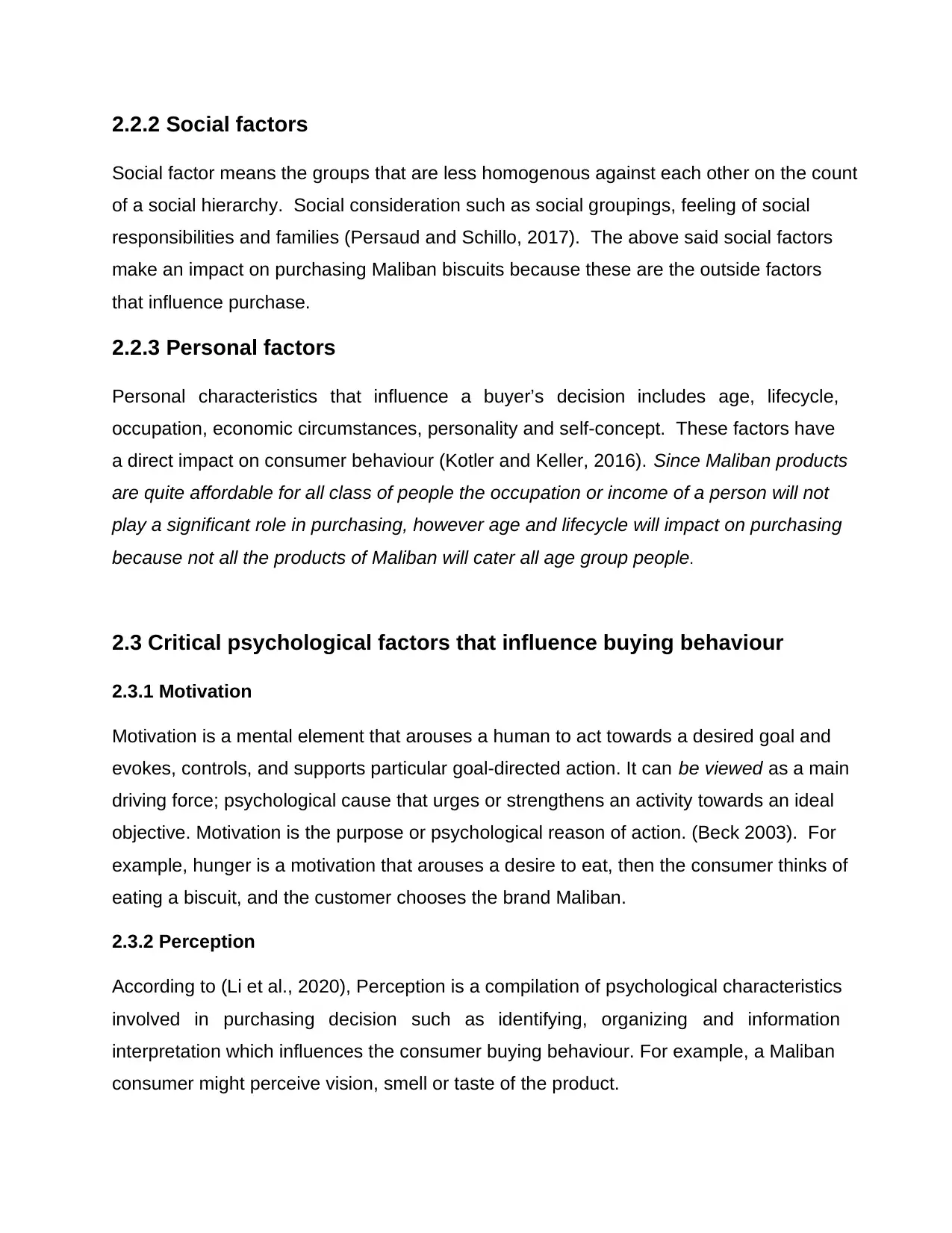
2.2.2 Social factors
Social factor means the groups that are less homogenous against each other on the count
of a social hierarchy. Social consideration such as social groupings, feeling of social
responsibilities and families (Persaud and Schillo, 2017). The above said social factors
make an impact on purchasing Maliban biscuits because these are the outside factors
that influence purchase.
2.2.3 Personal factors
Personal characteristics that influence a buyer’s decision includes age, lifecycle,
occupation, economic circumstances, personality and self-concept. These factors have
a direct impact on consumer behaviour (Kotler and Keller, 2016). Since Maliban products
are quite affordable for all class of people the occupation or income of a person will not
play a significant role in purchasing, however age and lifecycle will impact on purchasing
because not all the products of Maliban will cater all age group people.
2.3 Critical psychological factors that influence buying behaviour
2.3.1 Motivation
Motivation is a mental element that arouses a human to act towards a desired goal and
evokes, controls, and supports particular goal-directed action. It can be viewed as a main
driving force; psychological cause that urges or strengthens an activity towards an ideal
objective. Motivation is the purpose or psychological reason of action. (Beck 2003). For
example, hunger is a motivation that arouses a desire to eat, then the consumer thinks of
eating a biscuit, and the customer chooses the brand Maliban.
2.3.2 Perception
According to (Li et al., 2020), Perception is a compilation of psychological characteristics
involved in purchasing decision such as identifying, organizing and information
interpretation which influences the consumer buying behaviour. For example, a Maliban
consumer might perceive vision, smell or taste of the product.
Social factor means the groups that are less homogenous against each other on the count
of a social hierarchy. Social consideration such as social groupings, feeling of social
responsibilities and families (Persaud and Schillo, 2017). The above said social factors
make an impact on purchasing Maliban biscuits because these are the outside factors
that influence purchase.
2.2.3 Personal factors
Personal characteristics that influence a buyer’s decision includes age, lifecycle,
occupation, economic circumstances, personality and self-concept. These factors have
a direct impact on consumer behaviour (Kotler and Keller, 2016). Since Maliban products
are quite affordable for all class of people the occupation or income of a person will not
play a significant role in purchasing, however age and lifecycle will impact on purchasing
because not all the products of Maliban will cater all age group people.
2.3 Critical psychological factors that influence buying behaviour
2.3.1 Motivation
Motivation is a mental element that arouses a human to act towards a desired goal and
evokes, controls, and supports particular goal-directed action. It can be viewed as a main
driving force; psychological cause that urges or strengthens an activity towards an ideal
objective. Motivation is the purpose or psychological reason of action. (Beck 2003). For
example, hunger is a motivation that arouses a desire to eat, then the consumer thinks of
eating a biscuit, and the customer chooses the brand Maliban.
2.3.2 Perception
According to (Li et al., 2020), Perception is a compilation of psychological characteristics
involved in purchasing decision such as identifying, organizing and information
interpretation which influences the consumer buying behaviour. For example, a Maliban
consumer might perceive vision, smell or taste of the product.
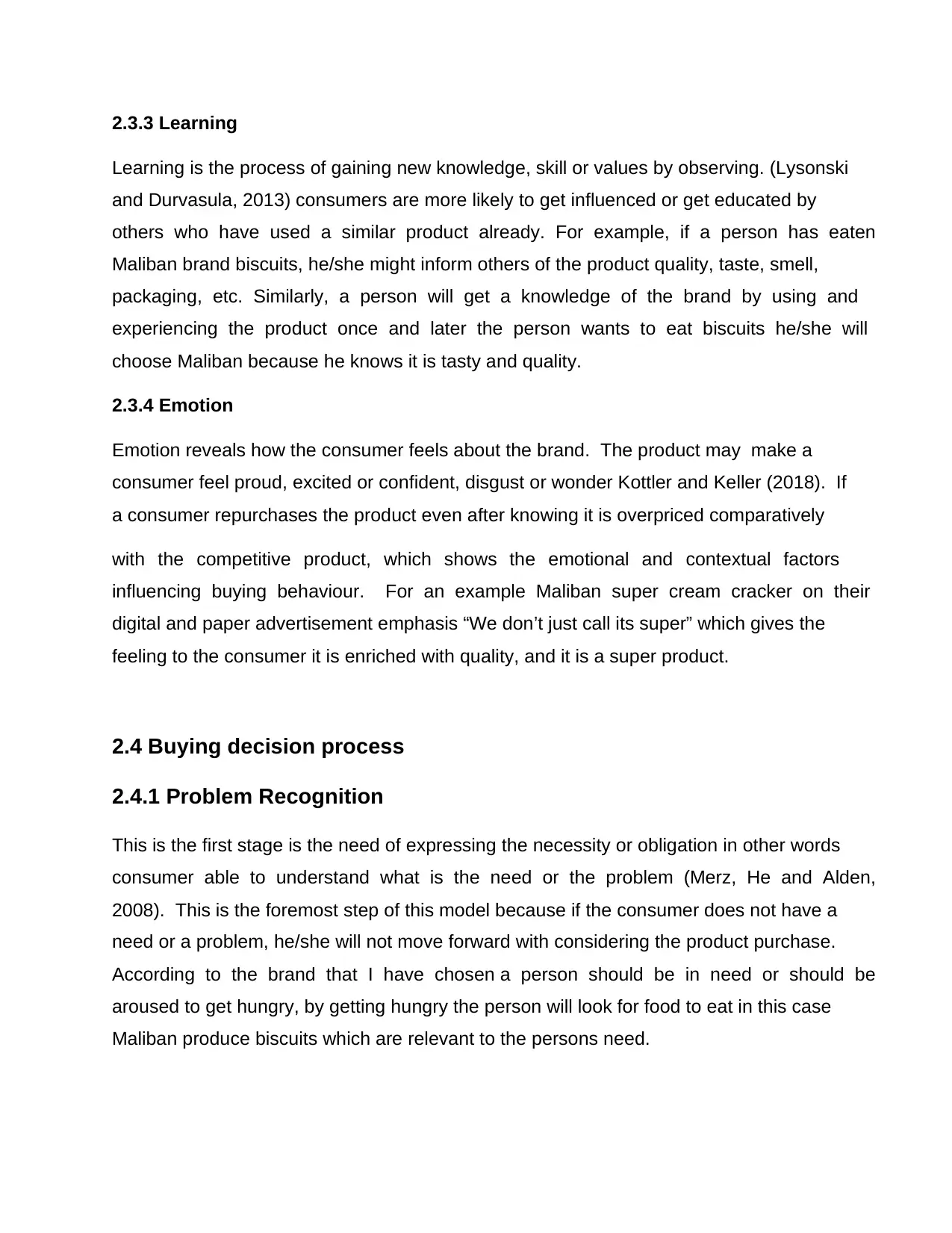
2.3.3 Learning
Learning is the process of gaining new knowledge, skill or values by observing. (Lysonski
and Durvasula, 2013) consumers are more likely to get influenced or get educated by
others who have used a similar product already. For example, if a person has eaten
Maliban brand biscuits, he/she might inform others of the product quality, taste, smell,
packaging, etc. Similarly, a person will get a knowledge of the brand by using and
experiencing the product once and later the person wants to eat biscuits he/she will
choose Maliban because he knows it is tasty and quality.
2.3.4 Emotion
Emotion reveals how the consumer feels about the brand. The product may make a
consumer feel proud, excited or confident, disgust or wonder Kottler and Keller (2018). If
a consumer repurchases the product even after knowing it is overpriced comparatively
with the competitive product, which shows the emotional and contextual factors
influencing buying behaviour. For an example Maliban super cream cracker on their
digital and paper advertisement emphasis “We don’t just call its super” which gives the
feeling to the consumer it is enriched with quality, and it is a super product.
2.4 Buying decision process
2.4.1 Problem Recognition
This is the first stage is the need of expressing the necessity or obligation in other words
consumer able to understand what is the need or the problem (Merz, He and Alden,
2008). This is the foremost step of this model because if the consumer does not have a
need or a problem, he/she will not move forward with considering the product purchase.
According to the brand that I have chosen a person should be in need or should be
aroused to get hungry, by getting hungry the person will look for food to eat in this case
Maliban produce biscuits which are relevant to the persons need.
Learning is the process of gaining new knowledge, skill or values by observing. (Lysonski
and Durvasula, 2013) consumers are more likely to get influenced or get educated by
others who have used a similar product already. For example, if a person has eaten
Maliban brand biscuits, he/she might inform others of the product quality, taste, smell,
packaging, etc. Similarly, a person will get a knowledge of the brand by using and
experiencing the product once and later the person wants to eat biscuits he/she will
choose Maliban because he knows it is tasty and quality.
2.3.4 Emotion
Emotion reveals how the consumer feels about the brand. The product may make a
consumer feel proud, excited or confident, disgust or wonder Kottler and Keller (2018). If
a consumer repurchases the product even after knowing it is overpriced comparatively
with the competitive product, which shows the emotional and contextual factors
influencing buying behaviour. For an example Maliban super cream cracker on their
digital and paper advertisement emphasis “We don’t just call its super” which gives the
feeling to the consumer it is enriched with quality, and it is a super product.
2.4 Buying decision process
2.4.1 Problem Recognition
This is the first stage is the need of expressing the necessity or obligation in other words
consumer able to understand what is the need or the problem (Merz, He and Alden,
2008). This is the foremost step of this model because if the consumer does not have a
need or a problem, he/she will not move forward with considering the product purchase.
According to the brand that I have chosen a person should be in need or should be
aroused to get hungry, by getting hungry the person will look for food to eat in this case
Maliban produce biscuits which are relevant to the persons need.
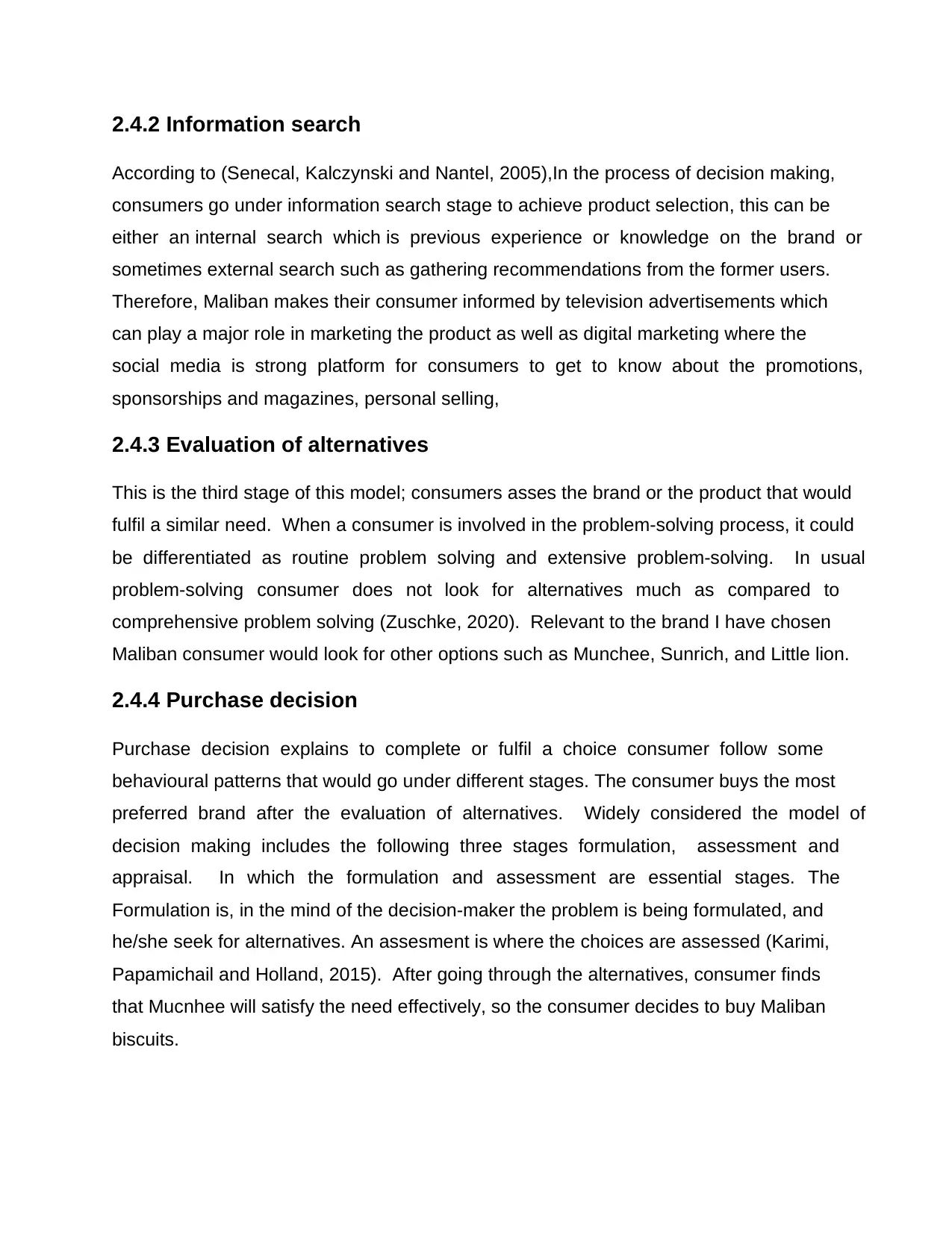
2.4.2 Information search
According to (Senecal, Kalczynski and Nantel, 2005),In the process of decision making,
consumers go under information search stage to achieve product selection, this can be
either an internal search which is previous experience or knowledge on the brand or
sometimes external search such as gathering recommendations from the former users.
Therefore, Maliban makes their consumer informed by television advertisements which
can play a major role in marketing the product as well as digital marketing where the
social media is strong platform for consumers to get to know about the promotions,
sponsorships and magazines, personal selling,
2.4.3 Evaluation of alternatives
This is the third stage of this model; consumers asses the brand or the product that would
fulfil a similar need. When a consumer is involved in the problem-solving process, it could
be differentiated as routine problem solving and extensive problem-solving. In usual
problem-solving consumer does not look for alternatives much as compared to
comprehensive problem solving (Zuschke, 2020). Relevant to the brand I have chosen
Maliban consumer would look for other options such as Munchee, Sunrich, and Little lion.
2.4.4 Purchase decision
Purchase decision explains to complete or fulfil a choice consumer follow some
behavioural patterns that would go under different stages. The consumer buys the most
preferred brand after the evaluation of alternatives. Widely considered the model of
decision making includes the following three stages formulation, assessment and
appraisal. In which the formulation and assessment are essential stages. The
Formulation is, in the mind of the decision-maker the problem is being formulated, and
he/she seek for alternatives. An assesment is where the choices are assessed (Karimi,
Papamichail and Holland, 2015). After going through the alternatives, consumer finds
that Mucnhee will satisfy the need effectively, so the consumer decides to buy Maliban
biscuits.
According to (Senecal, Kalczynski and Nantel, 2005),In the process of decision making,
consumers go under information search stage to achieve product selection, this can be
either an internal search which is previous experience or knowledge on the brand or
sometimes external search such as gathering recommendations from the former users.
Therefore, Maliban makes their consumer informed by television advertisements which
can play a major role in marketing the product as well as digital marketing where the
social media is strong platform for consumers to get to know about the promotions,
sponsorships and magazines, personal selling,
2.4.3 Evaluation of alternatives
This is the third stage of this model; consumers asses the brand or the product that would
fulfil a similar need. When a consumer is involved in the problem-solving process, it could
be differentiated as routine problem solving and extensive problem-solving. In usual
problem-solving consumer does not look for alternatives much as compared to
comprehensive problem solving (Zuschke, 2020). Relevant to the brand I have chosen
Maliban consumer would look for other options such as Munchee, Sunrich, and Little lion.
2.4.4 Purchase decision
Purchase decision explains to complete or fulfil a choice consumer follow some
behavioural patterns that would go under different stages. The consumer buys the most
preferred brand after the evaluation of alternatives. Widely considered the model of
decision making includes the following three stages formulation, assessment and
appraisal. In which the formulation and assessment are essential stages. The
Formulation is, in the mind of the decision-maker the problem is being formulated, and
he/she seek for alternatives. An assesment is where the choices are assessed (Karimi,
Papamichail and Holland, 2015). After going through the alternatives, consumer finds
that Mucnhee will satisfy the need effectively, so the consumer decides to buy Maliban
biscuits.
Paraphrase This Document
Need a fresh take? Get an instant paraphrase of this document with our AI Paraphraser
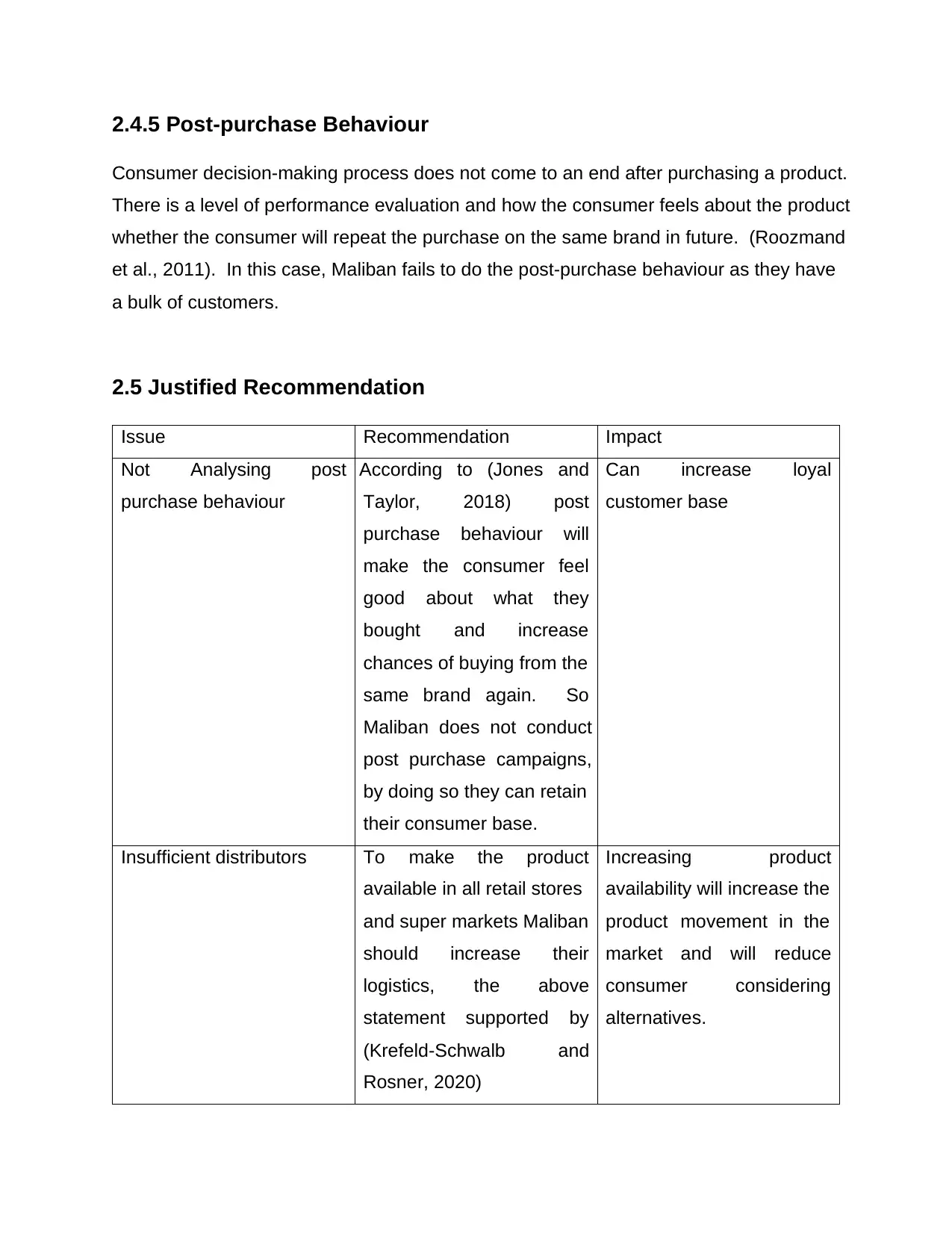
2.4.5 Post-purchase Behaviour
Consumer decision-making process does not come to an end after purchasing a product.
There is a level of performance evaluation and how the consumer feels about the product
whether the consumer will repeat the purchase on the same brand in future. (Roozmand
et al., 2011). In this case, Maliban fails to do the post-purchase behaviour as they have
a bulk of customers.
2.5 Justified Recommendation
Issue Recommendation Impact
Not Analysing post
purchase behaviour
According to (Jones and
Taylor, 2018) post
purchase behaviour will
make the consumer feel
good about what they
bought and increase
chances of buying from the
same brand again. So
Maliban does not conduct
post purchase campaigns,
by doing so they can retain
their consumer base.
Can increase loyal
customer base
Insufficient distributors To make the product
available in all retail stores
and super markets Maliban
should increase their
logistics, the above
statement supported by
(Krefeld-Schwalb and
Rosner, 2020)
Increasing product
availability will increase the
product movement in the
market and will reduce
consumer considering
alternatives.
Consumer decision-making process does not come to an end after purchasing a product.
There is a level of performance evaluation and how the consumer feels about the product
whether the consumer will repeat the purchase on the same brand in future. (Roozmand
et al., 2011). In this case, Maliban fails to do the post-purchase behaviour as they have
a bulk of customers.
2.5 Justified Recommendation
Issue Recommendation Impact
Not Analysing post
purchase behaviour
According to (Jones and
Taylor, 2018) post
purchase behaviour will
make the consumer feel
good about what they
bought and increase
chances of buying from the
same brand again. So
Maliban does not conduct
post purchase campaigns,
by doing so they can retain
their consumer base.
Can increase loyal
customer base
Insufficient distributors To make the product
available in all retail stores
and super markets Maliban
should increase their
logistics, the above
statement supported by
(Krefeld-Schwalb and
Rosner, 2020)
Increasing product
availability will increase the
product movement in the
market and will reduce
consumer considering
alternatives.

Higher promotional cost Rosi et al., (2017) agrees
on the point, Install
vending machines at public
places, schools, shopping
complexes and by doing
so the promotional cost will
limit because vending
machines are one time
investment which does not
carry any expenses in
future.
Will reduce the overhead
cost and increase
productivity.
Conclusion
Based on the report, the author have discussed how the consumer buying behavior
impacts on Maliban biscuits purchase. By discussing the theories of consumer buying
behavior and applying it to CBL Maliban, Author came to an understanding on how the
consumers select, use or dispose on purchasing.
Overall in this report the reader can get an idea about consumer characteristics, key
psychological process and buying decision process.
Author’s suggestion and recommendation on the above would be to focus more on the
buying decision process because it has a direct impact on the business. By doing so we
can understand the expectation of consumers, and it helps to understand what makes a
consumer to buy the product. Ultimately the purpose would be to satisfy the needs and
wants of the consumers. By getting an understanding about consumer buying behavior
marketers can make their marketing strategy very effective. Finally as products are made
to cater consumers’ demands, therefore the product should be carefully marketed for a
successful achievement of company goals.
on the point, Install
vending machines at public
places, schools, shopping
complexes and by doing
so the promotional cost will
limit because vending
machines are one time
investment which does not
carry any expenses in
future.
Will reduce the overhead
cost and increase
productivity.
Conclusion
Based on the report, the author have discussed how the consumer buying behavior
impacts on Maliban biscuits purchase. By discussing the theories of consumer buying
behavior and applying it to CBL Maliban, Author came to an understanding on how the
consumers select, use or dispose on purchasing.
Overall in this report the reader can get an idea about consumer characteristics, key
psychological process and buying decision process.
Author’s suggestion and recommendation on the above would be to focus more on the
buying decision process because it has a direct impact on the business. By doing so we
can understand the expectation of consumers, and it helps to understand what makes a
consumer to buy the product. Ultimately the purpose would be to satisfy the needs and
wants of the consumers. By getting an understanding about consumer buying behavior
marketers can make their marketing strategy very effective. Finally as products are made
to cater consumers’ demands, therefore the product should be carefully marketed for a
successful achievement of company goals.
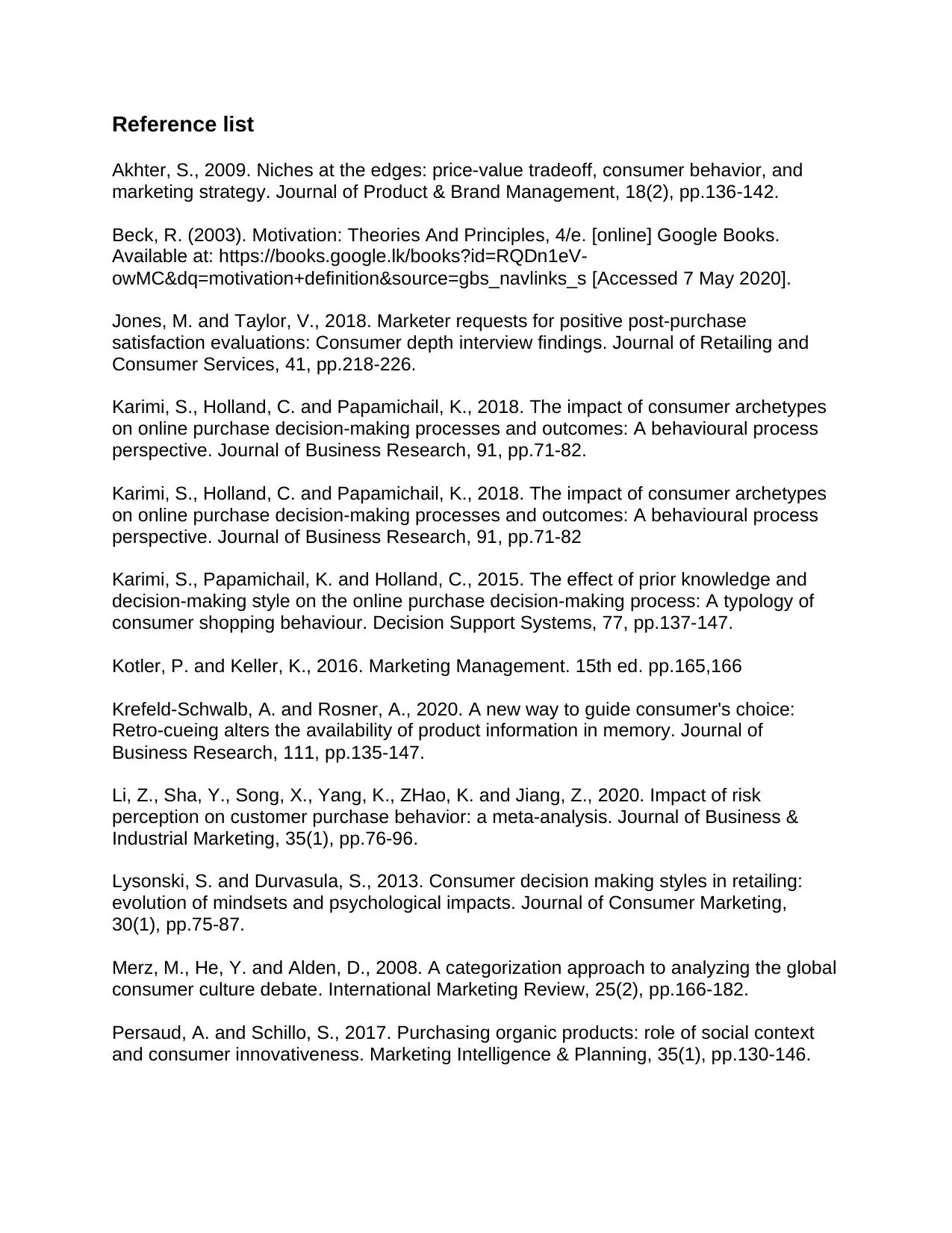
Reference list
Akhter, S., 2009. Niches at the edges: price‐value tradeoff, consumer behavior, and
marketing strategy. Journal of Product & Brand Management, 18(2), pp.136-142.
Beck, R. (2003). Motivation: Theories And Principles, 4/e. [online] Google Books.
Available at: https://books.google.lk/books?id=RQDn1eV-
owMC&dq=motivation+definition&source=gbs_navlinks_s [Accessed 7 May 2020].
Jones, M. and Taylor, V., 2018. Marketer requests for positive post-purchase
satisfaction evaluations: Consumer depth interview findings. Journal of Retailing and
Consumer Services, 41, pp.218-226.
Karimi, S., Holland, C. and Papamichail, K., 2018. The impact of consumer archetypes
on online purchase decision-making processes and outcomes: A behavioural process
perspective. Journal of Business Research, 91, pp.71-82.
Karimi, S., Holland, C. and Papamichail, K., 2018. The impact of consumer archetypes
on online purchase decision-making processes and outcomes: A behavioural process
perspective. Journal of Business Research, 91, pp.71-82
Karimi, S., Papamichail, K. and Holland, C., 2015. The effect of prior knowledge and
decision-making style on the online purchase decision-making process: A typology of
consumer shopping behaviour. Decision Support Systems, 77, pp.137-147.
Kotler, P. and Keller, K., 2016. Marketing Management. 15th ed. pp.165,166
Krefeld-Schwalb, A. and Rosner, A., 2020. A new way to guide consumer's choice:
Retro-cueing alters the availability of product information in memory. Journal of
Business Research, 111, pp.135-147.
Li, Z., Sha, Y., Song, X., Yang, K., ZHao, K. and Jiang, Z., 2020. Impact of risk
perception on customer purchase behavior: a meta-analysis. Journal of Business &
Industrial Marketing, 35(1), pp.76-96.
Lysonski, S. and Durvasula, S., 2013. Consumer decision making styles in retailing:
evolution of mindsets and psychological impacts. Journal of Consumer Marketing,
30(1), pp.75-87.
Merz, M., He, Y. and Alden, D., 2008. A categorization approach to analyzing the global
consumer culture debate. International Marketing Review, 25(2), pp.166-182.
Persaud, A. and Schillo, S., 2017. Purchasing organic products: role of social context
and consumer innovativeness. Marketing Intelligence & Planning, 35(1), pp.130-146.
Akhter, S., 2009. Niches at the edges: price‐value tradeoff, consumer behavior, and
marketing strategy. Journal of Product & Brand Management, 18(2), pp.136-142.
Beck, R. (2003). Motivation: Theories And Principles, 4/e. [online] Google Books.
Available at: https://books.google.lk/books?id=RQDn1eV-
owMC&dq=motivation+definition&source=gbs_navlinks_s [Accessed 7 May 2020].
Jones, M. and Taylor, V., 2018. Marketer requests for positive post-purchase
satisfaction evaluations: Consumer depth interview findings. Journal of Retailing and
Consumer Services, 41, pp.218-226.
Karimi, S., Holland, C. and Papamichail, K., 2018. The impact of consumer archetypes
on online purchase decision-making processes and outcomes: A behavioural process
perspective. Journal of Business Research, 91, pp.71-82.
Karimi, S., Holland, C. and Papamichail, K., 2018. The impact of consumer archetypes
on online purchase decision-making processes and outcomes: A behavioural process
perspective. Journal of Business Research, 91, pp.71-82
Karimi, S., Papamichail, K. and Holland, C., 2015. The effect of prior knowledge and
decision-making style on the online purchase decision-making process: A typology of
consumer shopping behaviour. Decision Support Systems, 77, pp.137-147.
Kotler, P. and Keller, K., 2016. Marketing Management. 15th ed. pp.165,166
Krefeld-Schwalb, A. and Rosner, A., 2020. A new way to guide consumer's choice:
Retro-cueing alters the availability of product information in memory. Journal of
Business Research, 111, pp.135-147.
Li, Z., Sha, Y., Song, X., Yang, K., ZHao, K. and Jiang, Z., 2020. Impact of risk
perception on customer purchase behavior: a meta-analysis. Journal of Business &
Industrial Marketing, 35(1), pp.76-96.
Lysonski, S. and Durvasula, S., 2013. Consumer decision making styles in retailing:
evolution of mindsets and psychological impacts. Journal of Consumer Marketing,
30(1), pp.75-87.
Merz, M., He, Y. and Alden, D., 2008. A categorization approach to analyzing the global
consumer culture debate. International Marketing Review, 25(2), pp.166-182.
Persaud, A. and Schillo, S., 2017. Purchasing organic products: role of social context
and consumer innovativeness. Marketing Intelligence & Planning, 35(1), pp.130-146.
Secure Best Marks with AI Grader
Need help grading? Try our AI Grader for instant feedback on your assignments.
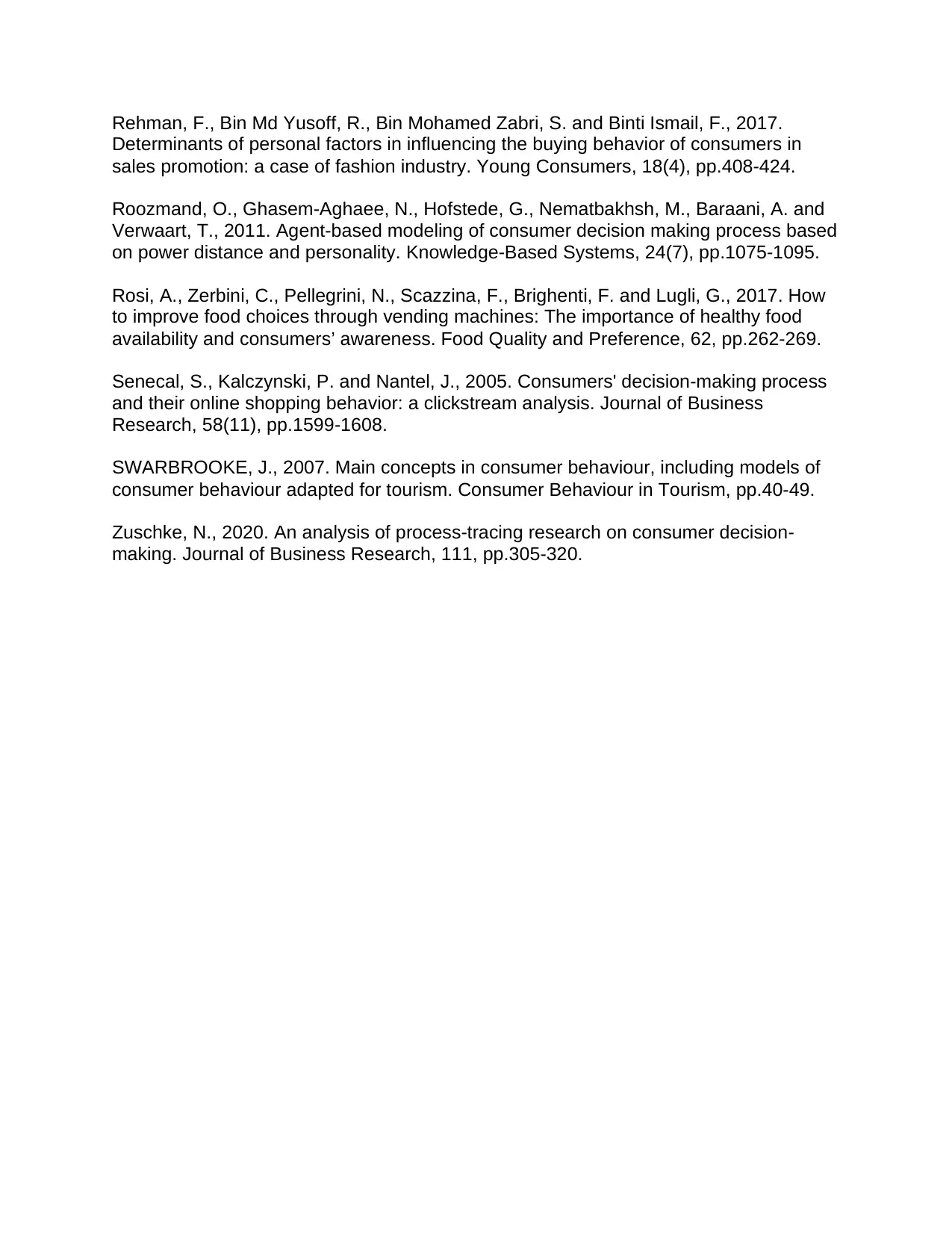
Rehman, F., Bin Md Yusoff, R., Bin Mohamed Zabri, S. and Binti Ismail, F., 2017.
Determinants of personal factors in influencing the buying behavior of consumers in
sales promotion: a case of fashion industry. Young Consumers, 18(4), pp.408-424.
Roozmand, O., Ghasem-Aghaee, N., Hofstede, G., Nematbakhsh, M., Baraani, A. and
Verwaart, T., 2011. Agent-based modeling of consumer decision making process based
on power distance and personality. Knowledge-Based Systems, 24(7), pp.1075-1095.
Rosi, A., Zerbini, C., Pellegrini, N., Scazzina, F., Brighenti, F. and Lugli, G., 2017. How
to improve food choices through vending machines: The importance of healthy food
availability and consumers’ awareness. Food Quality and Preference, 62, pp.262-269.
Senecal, S., Kalczynski, P. and Nantel, J., 2005. Consumers' decision-making process
and their online shopping behavior: a clickstream analysis. Journal of Business
Research, 58(11), pp.1599-1608.
SWARBROOKE, J., 2007. Main concepts in consumer behaviour, including models of
consumer behaviour adapted for tourism. Consumer Behaviour in Tourism, pp.40-49.
Zuschke, N., 2020. An analysis of process-tracing research on consumer decision-
making. Journal of Business Research, 111, pp.305-320.
Determinants of personal factors in influencing the buying behavior of consumers in
sales promotion: a case of fashion industry. Young Consumers, 18(4), pp.408-424.
Roozmand, O., Ghasem-Aghaee, N., Hofstede, G., Nematbakhsh, M., Baraani, A. and
Verwaart, T., 2011. Agent-based modeling of consumer decision making process based
on power distance and personality. Knowledge-Based Systems, 24(7), pp.1075-1095.
Rosi, A., Zerbini, C., Pellegrini, N., Scazzina, F., Brighenti, F. and Lugli, G., 2017. How
to improve food choices through vending machines: The importance of healthy food
availability and consumers’ awareness. Food Quality and Preference, 62, pp.262-269.
Senecal, S., Kalczynski, P. and Nantel, J., 2005. Consumers' decision-making process
and their online shopping behavior: a clickstream analysis. Journal of Business
Research, 58(11), pp.1599-1608.
SWARBROOKE, J., 2007. Main concepts in consumer behaviour, including models of
consumer behaviour adapted for tourism. Consumer Behaviour in Tourism, pp.40-49.
Zuschke, N., 2020. An analysis of process-tracing research on consumer decision-
making. Journal of Business Research, 111, pp.305-320.
1 out of 11
Related Documents
Your All-in-One AI-Powered Toolkit for Academic Success.
+13062052269
info@desklib.com
Available 24*7 on WhatsApp / Email
![[object Object]](/_next/static/media/star-bottom.7253800d.svg)
Unlock your academic potential
© 2024 | Zucol Services PVT LTD | All rights reserved.



